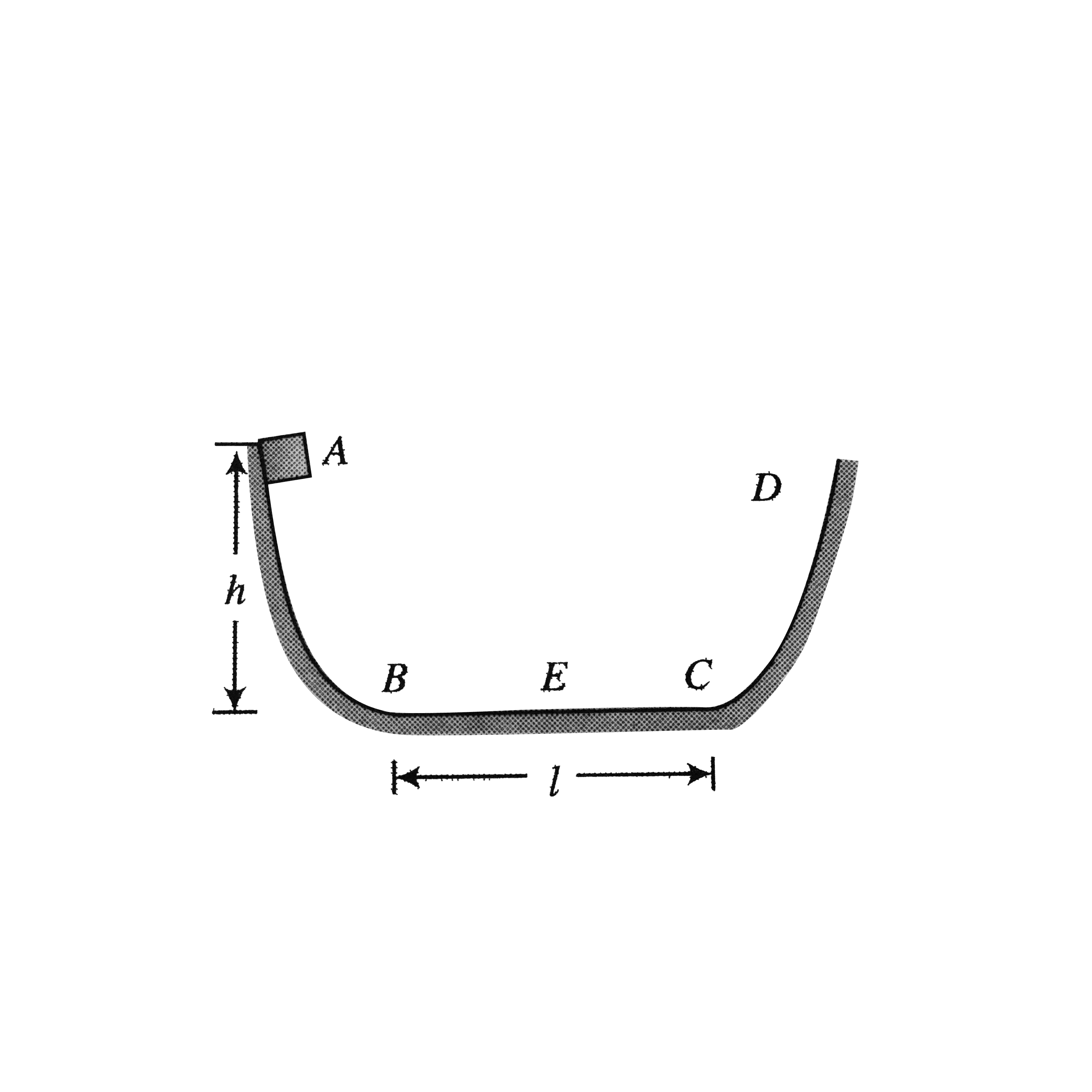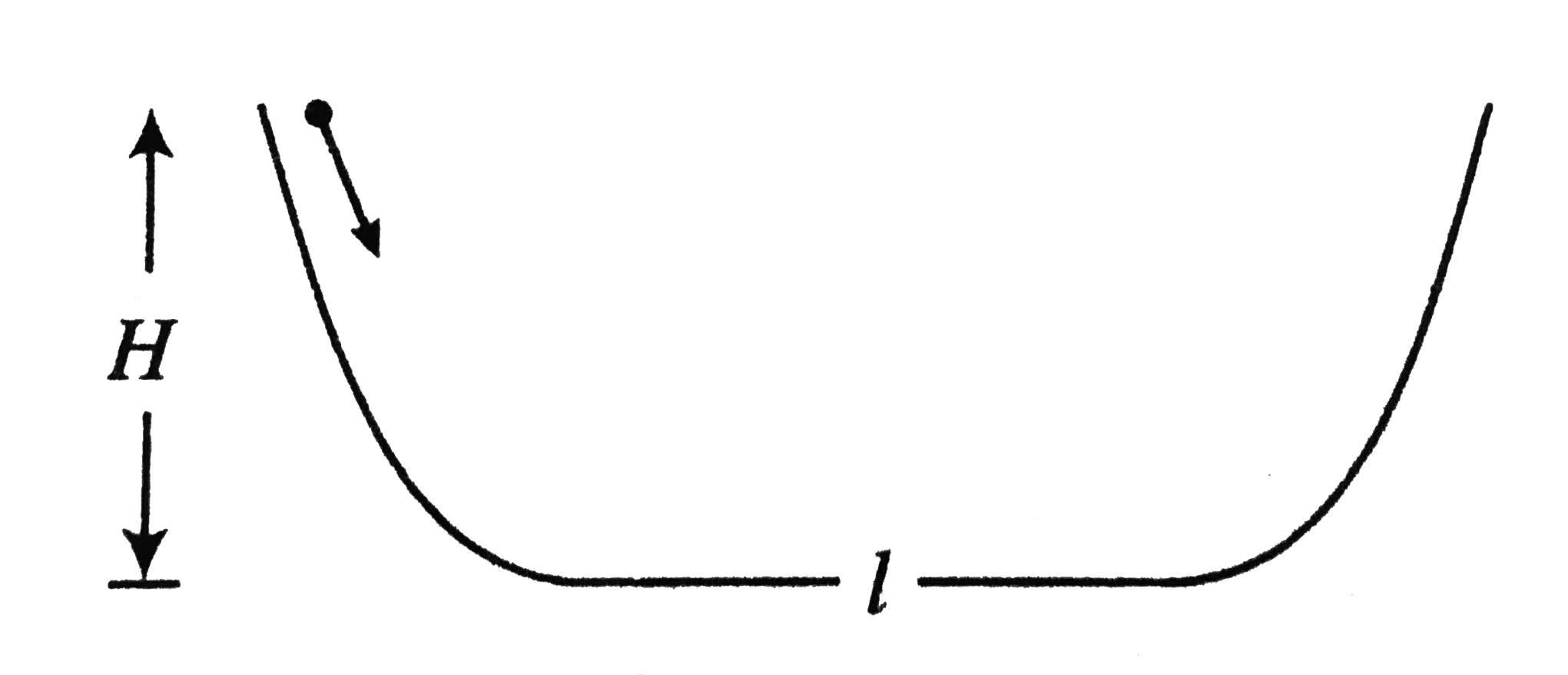A particle slides along a track with elevated ends and a flat central part as shown in Fig. The flat part has a length l = 3.0 m. The curved portions of the truck are fricionless. For the flat part the coefficient of kinetic friction is μk=0.20, the particle is released at point A which is at height h = 1.5 m above the flat part of the track. Where does the particle finally come to rest ?
As initial ME of the particle is mgh and final is zero, so loos in ME = mgh. This ME is lost in doing work against friction in the flat part, so
loss in ME WD against friction
mgh = μmgs

i.e.,s=hμ=1.50.2=7.5m
After starting from B the particle will each C and then will rise up till the remaining KE at C is converted into potential energy. It will then again descend and at C will have the same from C to B, the same will be repeated and finally the particle will come to rest at E such that
BC+CB+BE=7.5=3+3+BE=7.5
BE = 1.5
So the particle comes to rest at the centre of the flat part.
Topper's Solved these Questions
- WORK, POWER & ENERGY BOOK - AAKASH SERIESCHAPTER - WORK, POWER & ENERGY EXERCISE - EXERCISE - I
78 Videos
- WORK, POWER & ENERGY BOOK - AAKASH SERIESCHAPTER - WORK, POWER & ENERGY EXERCISE - EXERCISE - II (SCALARS (OR) DOT PRODUCT)
9 Videos
- WORK POWER ENERGYBOOK - AAKASH SERIESCHAPTER - WORK POWER ENERGYEXERCISE - EXERCISE - 3
61 Videos
Similar Questions
A particle slides along a track with elevated ends and a flat central part as shown in figure. The flat part has a length l=3m. The curved portions of the track are frictionless. For the flat part, the coefficient of kinetic friction is μk=0.2. The particle is released at point A which is at height h=1.5m above the flat part of the track. Where does the particle finally come to rest?

View SolutionA particle slides along a track with elevated ends and a flat central part as shown in figure. The flat part has a length l=3m. The curved portions of the track are frictionless. For the flat part, the coefficient of kinetic friction is μk=0.2. The particle is released at point A which is at height h=1.5m above the flat part of the track. Where does the particle finally come to rest?

View Solution
Knowledge Check
A particle of mass m slides along a curved-flat-curved track. The curved portions of the track are smooth. If the particle is released at the top of one of the curved portions, the particle comes to rest at flat portion of length l and of μ=μkinetic after covering a distance of
 A(a) l3μB(b) H2μkineticC(c) l6D(d) Hμkinetic
A(a) l3μB(b) H2μkineticC(c) l6D(d) HμkineticA 0.5kg block slides from the point A on a horizontal track with an initial speed 3m/s towards a weightless horizontal spring of length 1m and force constant 2N/m. The part AB of the track is frictionless and the part BC has the coefficient of static and kinetic friction as '0.22' and 0.20 respectively. If the distances AB and BD are 2m and 2.14m respectively, find total distance through which the block moves before it comes to rest completely. (g=10 m//s^(2) ).
A3.23 mB4.14 mC5.24 mD4.67 mA track has two inclined surface AB and DC each of length 3 m and angle of inclination of 30∘ with the horizontal and a central horizontal part of length 4m shown in figure. A block of mass 0.2 kg slides from rest from point A. The inclined surfaces are frictionless. If the coefficient of friction between the block and the horizontal flat surface is 0.2, where will the block finally come to rest ? [in 10−1m]
 A0.5 m away from point BB3.5 m away from point BC0.5 m away from point CD1.5 m away from point C
A0.5 m away from point BB3.5 m away from point BC0.5 m away from point CD1.5 m away from point C
A particle slides along a track with elevated ends and a flat central part as shown in figure. The flat part has a length l=3m. The curved portions of the track are frictionless. For the flat part, the coefficient of kinetic friction is μk=0.2. The particle is released at point A which is at height h=1.5m above the flat part of the track. Where does the particle finally come to rest?

View SolutionThe flat portion of leaf is called
View SolutionA particle of mass m slides along a curved-flat-curved track. The curved portions of the track are smooth. If the particle is released at the top of one of the curved portions, the particle comes to rest at flat portion of length l and of μ=μkinetic after covering a distance of

View SolutionA small block slide along a path that is without friction until the block reaches the section l=3m, which begains at height h=3m on a flat incline of angle 37° , as shown. In that section, the coefficient of kinetic friction is 0.50. The block passes through point A with a speed of √136m/s. Find the speed of the block as it passes through point B where the friction ends, in m/s .(take g=10m/s2)
View SolutionA track has two inclined surface AB and DC each of length 3 m and angle of inclination of 30∘ with the horizontal and a central horizontal part of length 4m shown in figure. A block of mass 0.2 kg slides from rest from point A. The inclined surfaces are frictionless. If the coefficient of friction between the block and the horizontal flat surface is 0.2, where will the block finally come to rest ? [in 10−1m]

View Solution
